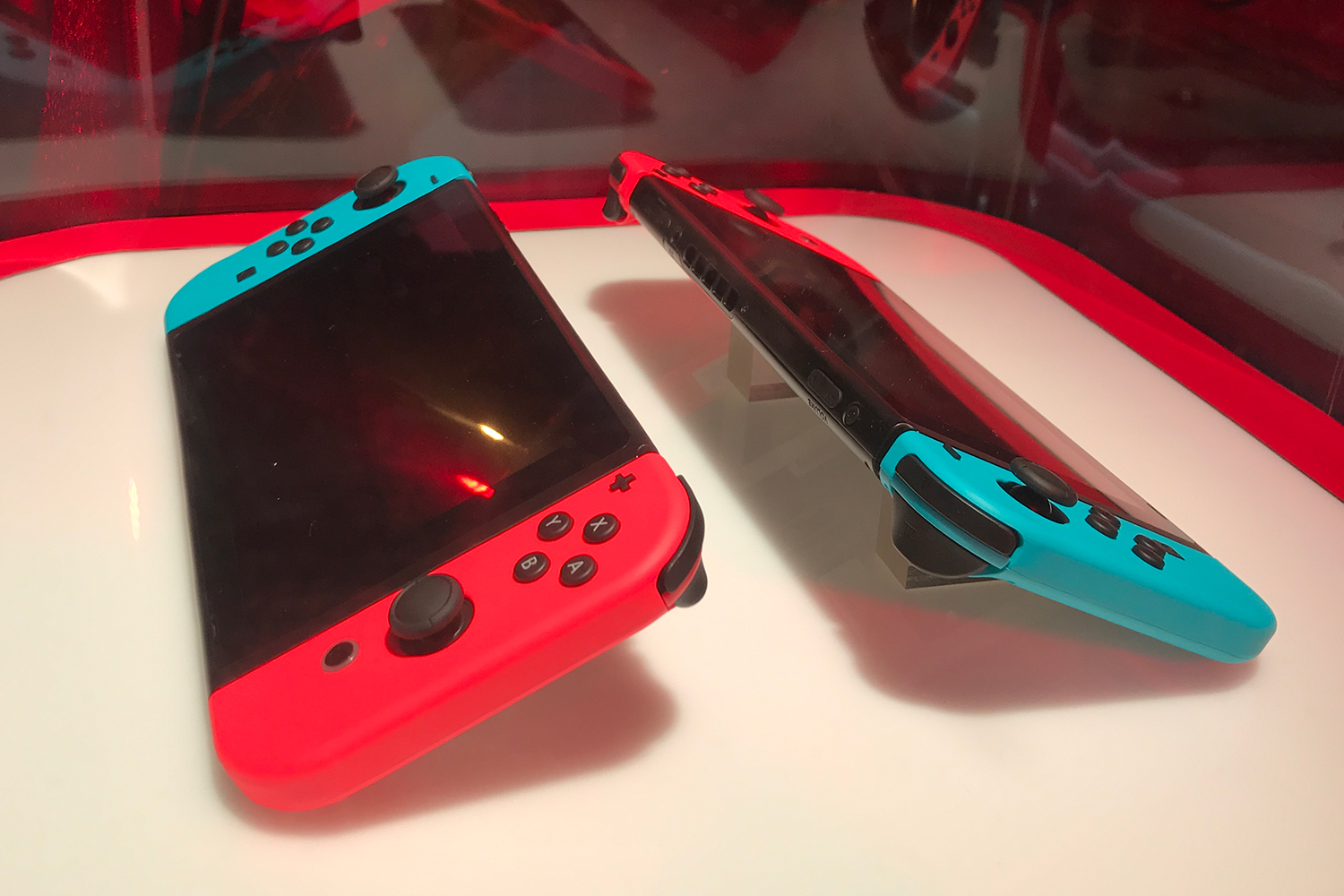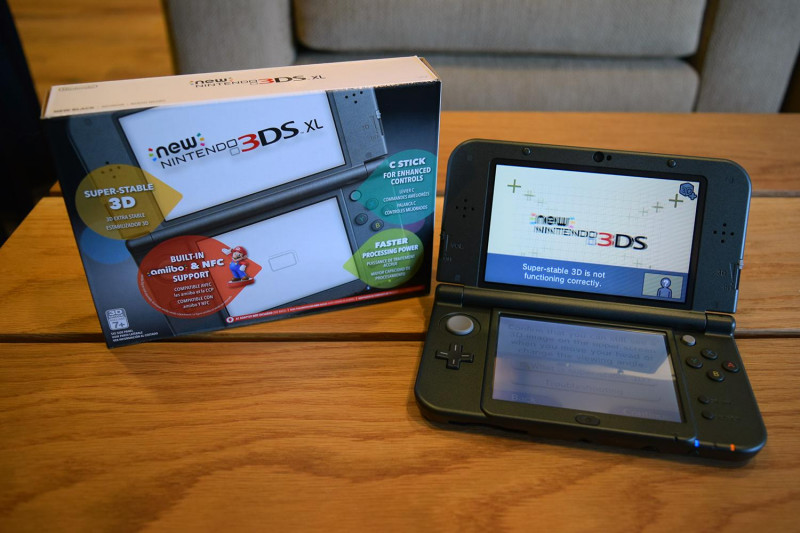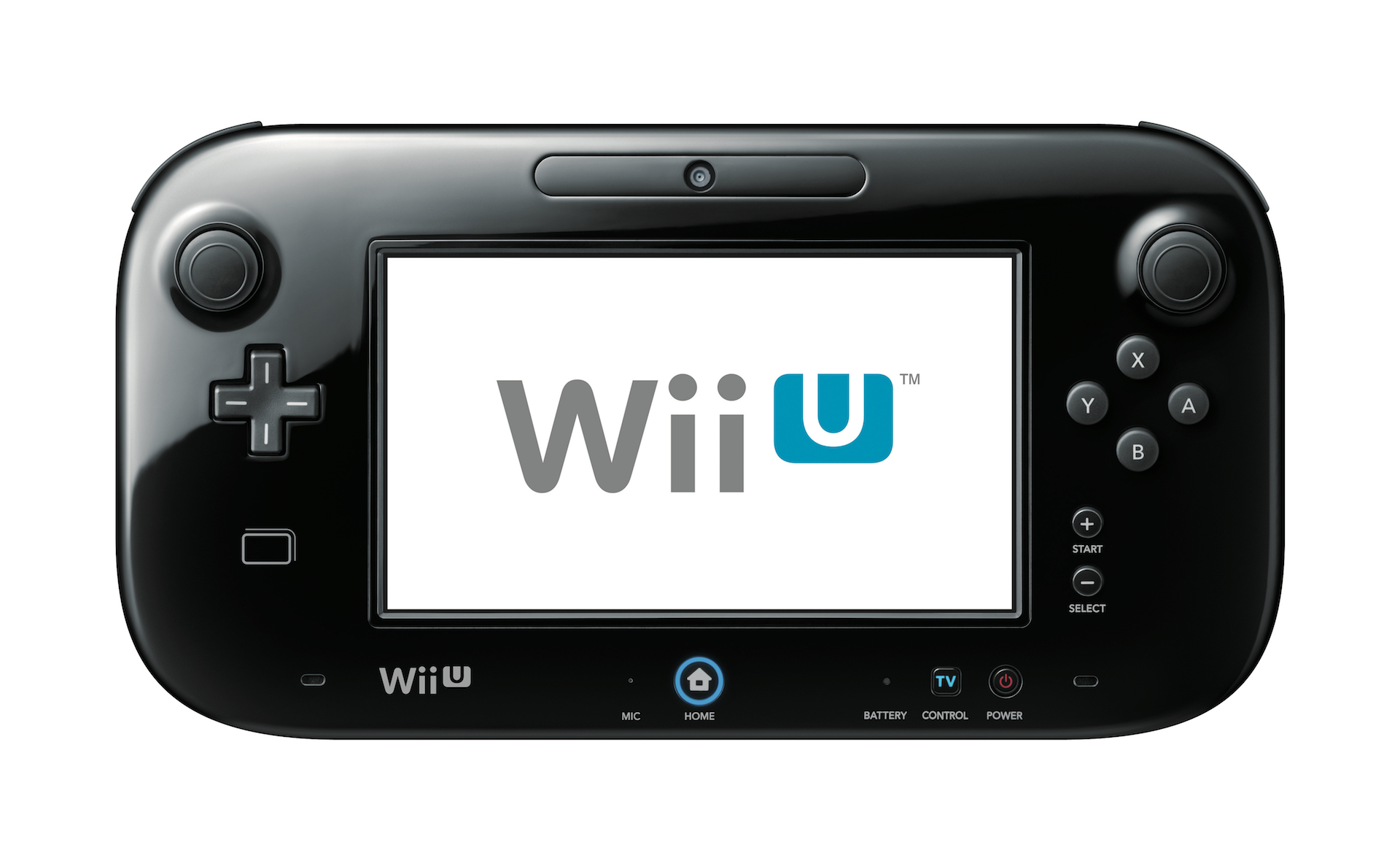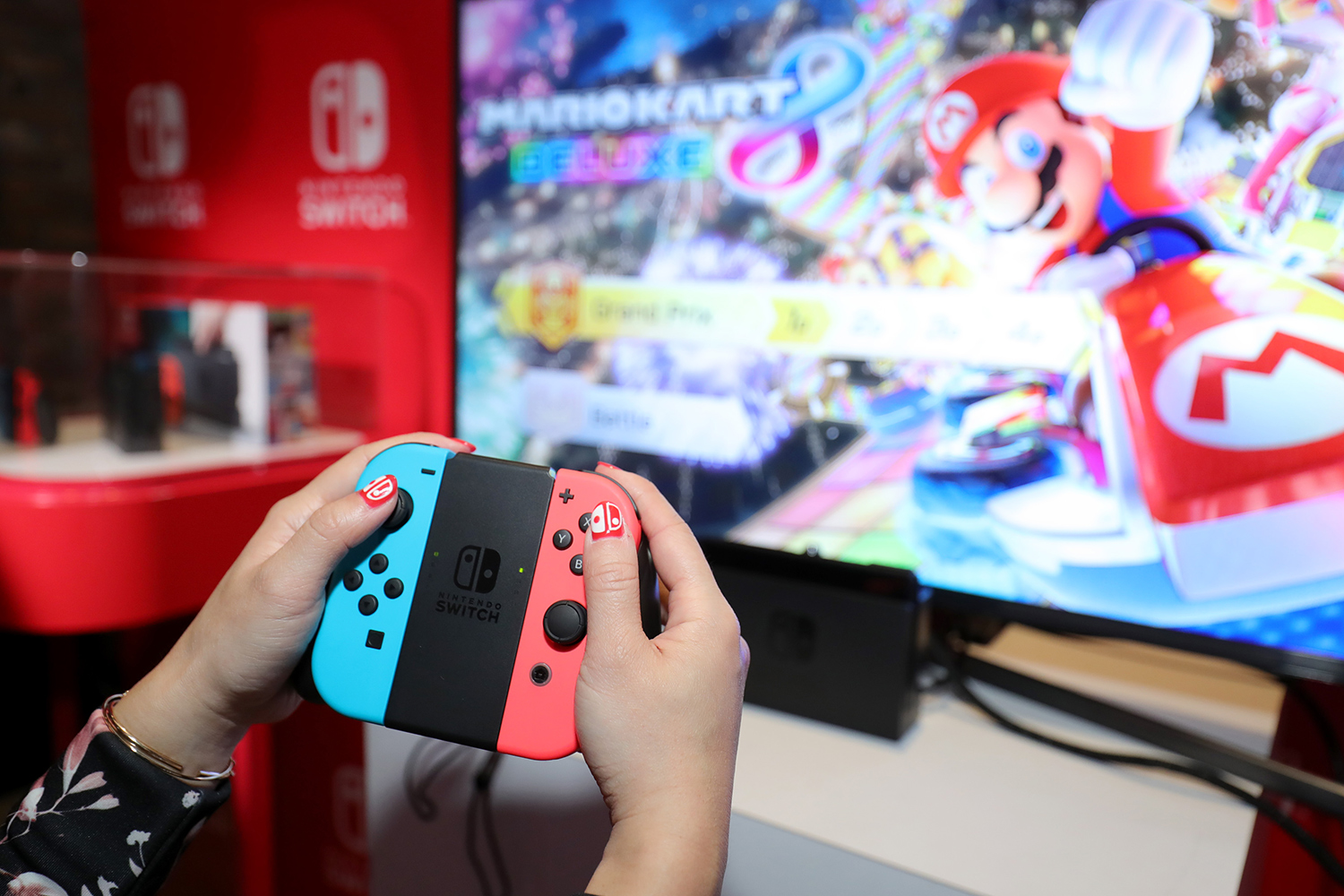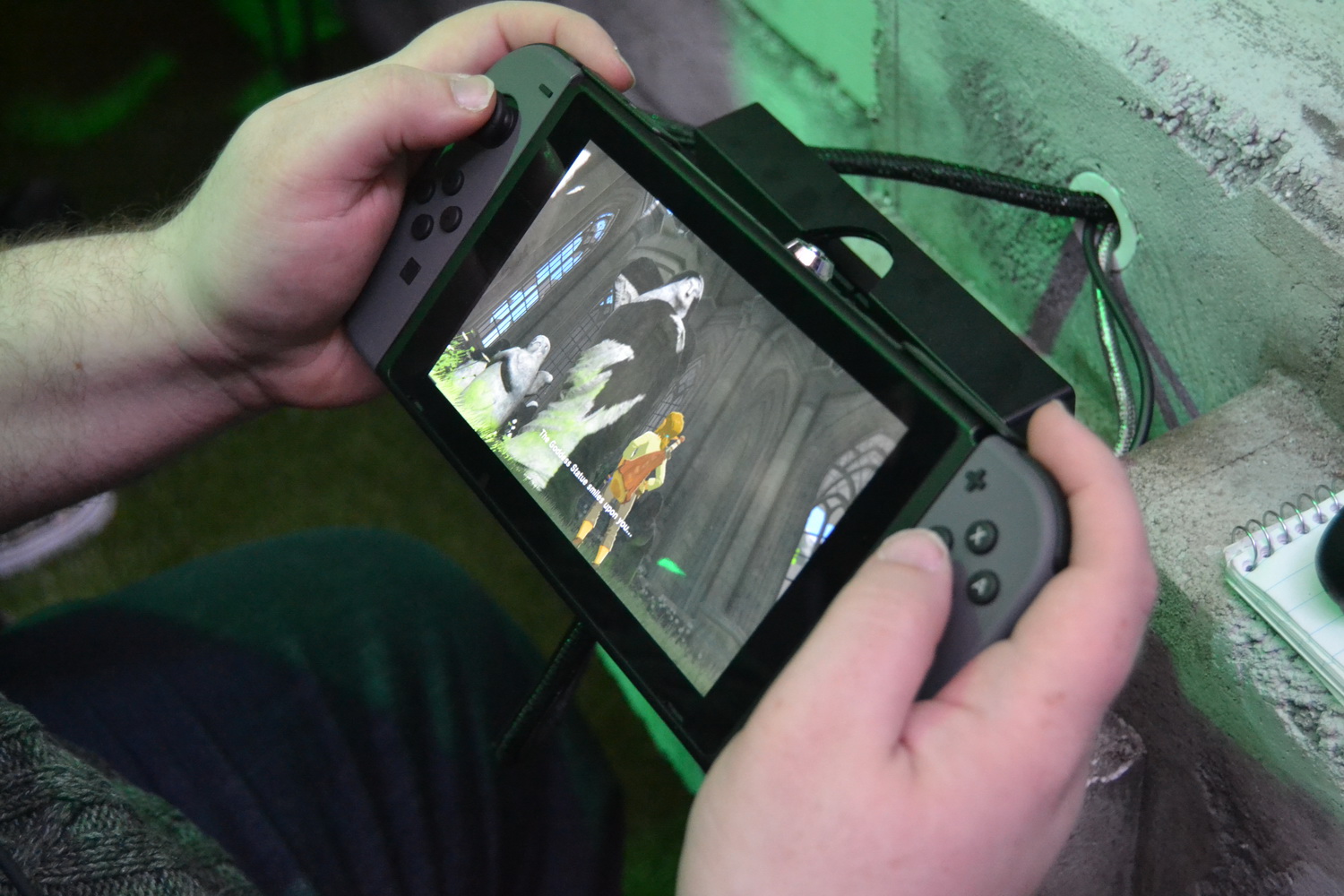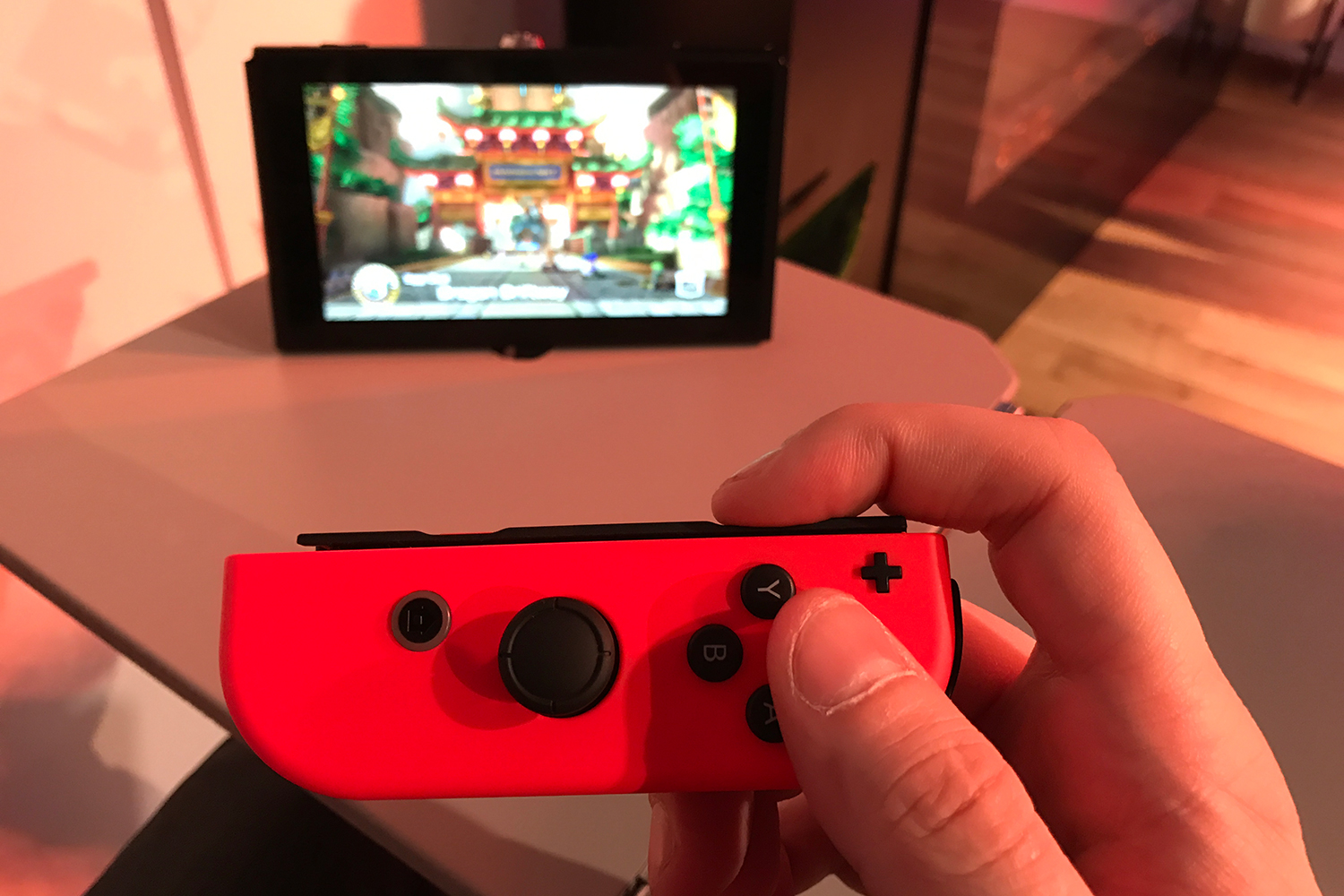
While the Wii U lifecycle will end before its fifth birthday rolls around this year, we think it’s important to put it side-by-side against the Switch to see how Nintendo’s newest systems stacks up against its last home console effort. The 3DS family of systems turns six later this month, and all signs point to it coexisting with the Nintendo Switch, meaning that for portable play, there will be two viable options.
Let’s take a look at the most important features of the three to uncover if the Switch looks to be a step in the right direction for Nintendo.
Specs
Nintendo Switch |
Wii U |
New Nintendo 3DS XL |
|
| Dimensions | 4 x 9.4 x .55 in (with Joy-Cons attached) | 5.3 in × 10.2 in × 0.9 in (gamepad) | 3.69 x 6.3 x .85 in (closed) |
| Weight | 297 g (398 g with Joy-Cons attached) | 491 g (gamepad) | 329 g |
| Screen | 6.3 in capacitive touchscreen | 6.2 in touchscreen | 4.8 in (upper) 4.18 in touchscreen (lower) |
| Resolution | 1280 x 720 (portable) 1920 x 1080 (console) | 854 x 480 (gamepad) 1920 x 720 (console) | 800 x 240 |
| Speakers | Stereo | Stereo | Stereo |
| CPU | Nvidia customized Tegra processor | IBM Power-based multi-core processor | 804 MHz ARM11 MPCore quad-core |
| GPU | Nvidia customized Tegra processor | AMD Radeon-based high definition | 4x VFPv2 Co-Processor |
| Storage | 32GB (expandable via Micro SDXC) | 32GB flash (expandable via external HDD) | 4GB microSD included (replaceable) |
| Sensors | Accelerometer, gyroscope, brightness | Accelerometer, gyroscope, geomagnetic | gyroscope |
| Battery | lithium ion 4310mAh | lithium ion 1500 mAh | lithium ion 1400 mAh |
| Battery life | 2.5 to 6 hours | 3 to 5 hours | 3.5 to 7 hours |
| Camera | No | Front | front, back |
| NFC Support | Yes | Yes | Yes |
| RAM | 4GB | 2GB (1GB allocated of OS) | 256MB FCRAM, 10MB VRAM |
| Bluetooth | Yes, 4.1 | No | No |
| Ports | USB Type-C, headphone | headphone | headphone |
| Connectivity | 802.11 a/b/g/n/ac Wi-Fi | 802.11b/g/n Wi-Fi | 802.11b/g Wi-Fi |
| Price | $300 | $200-$300 (no longer manufactured) | $200 |
Design
There are obvious visual similarities between all three of these platforms, when played in the palms of your hands, but there are some stark differences.
Physically, the Nintendo Switch resembles a high-end version of the Wii U gamepad, substituting plastic for a sturdy frame similar to that of the 3DS. The Switch is also remarkably thinner than the Wii U gamepad. The Switch barely edges out the Wii U in screen size, while the 3DS actually has more screen space if you count both of its screens.
At 398 grams, the Switch weighs less than the Wii U gamepad, even with the Joy-Cons attached, but more than the New 3DS XL. All three are fairly lightweight for the amount of space they take up.
The clamshell design of the 3DS keeps its screen shielded from scratches during travel, a feat that can only be achieved on the Wii U and Switch if a separate case is purchased.
It all depends on your hands and personal preference, but we believe that the 3DS shape and button layout is more comfortable than the Wii U gamepad. It’s hard to tell how the Switch will feel for long sessions, but early impressions suggest that it’s at as comfortable as the Wii U.
The Wii U has a front camera, while the 3DS has both camera on the front and back of the top plate. Interestingly, the Switch does not have a camera. All three support near-field communication which Nintendo primarily uses to sync the consoles with its data-enhance Amiibo figures.
Sound wise, all three support stereo through their speakers and standard headphone jacks. The Switch also adds Bluetooth support for communication. Additionally, the Switch does away with the proprietary charging ports of the Wii U and 3DS in favor of USB-Type C.
The Switch will support newer routers with AC Wi-Fi, but remains compliant with legacy Wi-Fi types. The Wii U tops out at N Wi-Fi, and the 3DS is type G, which doesn’t it affect it much as a handheld gaming device.
Each system has a gyroscope, and the Wii U and Switch each have an accelerometer. Additionally, the Wii U has a geomagnetic sensor, while the Switch Joy-Con controllers have an HD Rumble feature and the right Joy-Con has an IR sensor.
The Switch features a bevy of components, but remains compact. All of its internal components are stored beneath its screen, whereas the Wii U has a small unit that it draws its power from. The 3DS is the most economical with its design as a pure handheld, but the Switch takes sleek and stylish to new heights.
From built-in features to its elegant layout, the Switch certainly improves on the Wii U and 3DS, but it’s hard to say that it’s designed better for portable play than the 3DS. This will rely heavily on the eye of the beholder, but for now, we give the edge to the Nintendo Switch.
Winner: Nintendo Switch
Performance
While great games are ultimately the most important aspect of a worthwhile game console, great gameplay is almost always enhanced by quality performance. While none of Nintendo’s active and future consoles compete with the PlayStation 4 and Xbox One in this regard, the 3DS and Wii U perform well with what they have under their hoods, and from early impressions, it appears that the Switch will as well.
Nintendo typically keeps quiet about official CPU/GPU specifications, particularly for handhelds, but thanks to 3DS homebrew enthusiasts, we know its processing power. As usual, first party Nintendo games tend to perform the best. The added power from the original 3DS to the New 3DS XL makes it capable of handling massive games like Xenoblade Chronicles 3D, and run titles like Super Smash Bros. smoother than its predecessor.
Object rendering and textures, though, typically fall on the higher end of the range between Nintendo 64 and Nintendo Gamecube performance. Sure, many smartphone games look better than the 3DS, but for running games without a hitch, this dedicated handheld gaming system is a marvel. Compared to its console counterparts, though, it naturally lags behind.

The Wii U came out a year prior to the Xbox One and PS4, but performs similarly to the Xbox 360 and PS3. First party Nintendo titles like Super Mario 3D World and The Legend of Zelda: The Wind Waker Remastered do a great job of showing off the Wii U’s ability to produce a beautiful array of vibrant colors, but unfortunately, visuals as enticing as these have rarely been shown off on the console. To its credit, the system admirably keeps its performance from console play to tablet mode.
Both the 3DS and Wii U pale in comparison to the Switch in this category, though, meaning the Switch will seemingly provide the best performance available across both Nintendo consoles and handhelds. We only know that the Switch features a custom Nvidia Tegra chipset. That’s rather ambiguous, but from that, we can extrapolate that the Switch will feature at least 1 TFLOP of processing power, while still falling below the power of both the Xbox One and PS4. Compared to its Nintendo family, though, this is a huge upgrade, as the Wii U and 3DS fall well below 1 TFLOP.
Until we get more time with the console, it’s hard to say just how profound of a difference it will make, but judging by the myriad of performance improvements of Breath of the Wild on Switch compared to the Wii U version, it’s safe to say that the Switch will only widen the performance gap between itself and the Wii U as the console matures. It’s unclear whether the Switch will perform as well in portable mode as console play.
Barring any catastrophic issues, though, it’s clear that the Switch will far surpass the power of both the Wii U and 3DS, and settle in at least the same ballpark as the OG Xbox One, making it the likely winner here.
Winner: Nintendo Switch
Styles of play
Nintendo is known for innovating on controls and modes of play with its game hardware, so it’s no surprise that all three of these systems feature multiple styles of play.
The New Nintendo 3DS XL offers traditional gaming through its circle pad and buttons, while also featuring touchscreen gameplay with a stylus on its bottom screen. Nintendo has largely abandoned touch-centric gameplay on the 3DS, but many 3DS titles utilize the touchscreen for menus and other systems. The handheld’s accelerometer allows for motion gameplay, but this feature is sparsely included in games. 3D mode differentiates it from its console counterparts, but only a few games such as Super Mario 3D Land implement the 3D with a refined approach.
Like the 3DS, the Wii U can be played with traditional controls via the analog stick and buttons on the gamepad or Pro controller. Additionally, the gamepad features a touchscreen that is also mainly used with a stylus for menu systems during console play, but has been featured prominently in games like Yoshi’s Woolly World. Games can be played within range from the console directly on the gamepad. Following in the Wii’s footsteps, the Wii U has motion gaming via the gamepad’s gyroscope and accelerometer, as well as through standard Wii remotes. The added geomagnetic sensor helps hone in motion gaming on the gamepad, as it automatically guides the gamepad back to its absolute position.
The Switch borrows from both the Wii U and 3DS in this category, but essentially raises the bar. The hybrid system offers three modes of play: console mode, tabletop mode, and handheld mode. For console mode, the Joy-Cons either attach to the Joy-Con grip for traditional controls, or they can be used unattached like Wii remotes. The Joy-Cons provide enhanced motion controls with their HD Rumble feature, which makes it feel as if tiny marbles are rolling around in the controllers as you move them, effectively creating a more intuitive motion experience than that of the 3DS or Wii U.
In tabletop mode, the Switch is propped up on its kickstand, and the Joy-Con is turned on its side to resemble a tiny NES-style controller. With the Joy-Cons attached, the system becomes a portable powerhouse, with a layout similar to the Wii U. Additionally, the Switch’s touchscreen is capacitive, meaning that it allows multiple finger presses at once, trumping the single-touch displays in the Wii U and 3DS.
While all three platforms feature diverse styles of interaction, the Switch is the most robust by a landslide.
Winner: Nintendo Switch
Resolution
Resolution is one of the first noticeable aspects after booting up a game, and these three Nintendo products each fare well, despite lagging behind the competition.
Strictly a handheld unit, the New 3DS XL has the worst resolution of the three at 800 x 240. When in 3D mode, one half of the resolution is allocated for each eye. The New 3DS XL might not instantly grab your attention, but it does a much better job than the OG 3DS in terms of framerate — consistent 30fps that is capable of surpassing 50fps in games like Monster Hunter 4.
The Wii U and Switch have a pair of resolution marks a piece. When outputting from a TV, both run at 1080p and 60fps. The disparity comes when playing on portable screens. The Wii U gamepad displays in 480p at 60fps, which is not as disappointing as it sounds, but it’s still standard definition. The Switch matches the gamepad’s frames per second, but displays in a more vibrant 720p HD resolution.
Previously, it would be unfair to compare a console to a handheld in a category like resolution, but since the Switch is a hybrid, we can compare it to both the Wii U and the 3DS. Although the Switch doesn’t up the ante during console play, it does provide the first high definition portable experience in Nintendo’s long history.
Winner: Nintendo Switch
Content
At the end of the day, game systems are really all about the games. Fantastic pieces of hardware are nothing without great software. These three Nintendo platforms are at vastly different stages in their lifecycles — the Switch’s life hasn’t even started — but there are things to admire about all three.
In almost six years, more than 1,000 games have launched on the 3DS “family” of consoles, including the 3DS, 3DS XL, and New Nintendo 3DS, across its retail, eShop, and Virtual Console platforms. There’s plenty of shareware to be found in this enormous pile, but there are also dozens upon dozens of great games to choose from. The 3DS also has the added benefit, as a portable console, of cheaper software at retail. And since Nintendo has no plans to abandon the 3DS when the Switch launches, the number of quality games should only increase. Mario Sports Superstars, Fire Emblem Echoes: Shadows of Valentia, and Dragon Quest XI are all on the 3DS horizon in the coming months.
In under five years, the Wii U amassed over 700 games. Like the 3DS, much of its library is populated with shareware, but there were some gems: Super Mario 3D World, Splatoon, Mario Kart 8, Super Smash Bros., Bayonetta 2, a pair of high definition Zelda remasters. In general, though, the Wii U was a ow point in terms of first party software, and a barren wasteland for third party support. The Legend of Zelda: Breath of the Wild will be the final Nintendo title released for Wii U, bringing the Wii U era to a close.

As for the newcomer, much has been said about the Switch’s desolate launch lineup. Besides Breath of the Wild and Super Bomberman R, there isn’t much new to get excited at launch. By the end of summer though, a definitive version of Mario Kart 8 and a sequel to Splatoon will grace the console, and titles like Sonic Mania and Xenoblade Chronicles 2 are sure to satisfy many later this year. Really, though, it’s Super Mario Odyssey, the return to the sandbox-style Mario that was sorely missed on the Wii U that hints at a promising future for the Switch. Nintendo claims that over 100 games are currently in development for Switch, and with publishers like EA pledging serious support for sports titles — a genre that has been noticeably absent from recent Nintendo consoles — perhaps the Switch will indeed fare better with third party support.
Even with all that promise and well-wishing, continued support for an already vast 3DS library means that the handheld will remain on top in the games department for quite some time.
Winner: New Nintendo 3DS XL
Storage
Nintendo consistently deviates from the norm in many respects, including storage. All three systems provide minimal storage out of the gate, but are capable of expansion.
The Wii U comes in two forms, a ridiculously low 8GB model, and a 32GB model. Both feature internal flash storage, and can fill up quickly with system updates and game downloads.
Since the 3DS and Switch use game cartridges instead of discs, which have some internal storage. However, both consoles feature expandable storage using different types of SD cards. The New Nintendo 3DS XL comes with a 4GB micro SD card, and supports larger, Micro SD and SDHC cards. The Switch comes with features a 32GB of internal storage, and has supports both Micro SDHC and SDXC cards.

Out of the box, the Switch would be the winner of the three, slightly edging out the Wii U, since less space is needed for game installs due to game cartridges. However, considering that most users have or will need to expand the storage of all three, the means for expanding storage comes into play.
Nintendo 3DS games are inherently smaller than console games, so an upgrade to a 64GB or even 32GB card is likely enough to last users for the long haul. As for the Switch, the size of the games . Currently, however, the highest capacity microSDXC card available is 512GB, but Nintendo said the Switch will support upcoming 1TB and 2TB SDXC cards.
The Wii U, though, thanks to external hard drive support, can be expanded astronomically on a budget. A 1TB external hard drive can be purchased regularly for around $50.
Since we won’t know how fast the Switch will eat up storage space, or when high capacity microSD cards will drop in price, we have to give the nod to the Wii U, at least for now.
Winner: Wii U
Battery life
Battery Life is crucial for portable hardware. It’s never fun for your game system to run out of juice on the subway, far away from a charger.
As the Wii U cannot be played on the gamepad more than 25 feet or so from its main console, its three to five hour battery life is less of an issue than that of the 3DS or Switch. Additionally, the Wii U’s small lithium ion battery can be replaced with a larger one to increase battery life to 8 hours. The Wii U gamepad takes approximately 2.5 hours to fully charge.
The Switch has a range of 2.5 to 6 hours, with intensive games like The Legend of Zelda: Breath of the Wild capable of chugging along for roughly three hours while on the go. It takes three hours for the unit to fully charge while in sleep mode. Since the Switch far surpasses the 3DS in power, it’s impressive that its battery life range is close to that of its handheld cousin.

Still, with an official range of 3.5 to 7 hours, the New Nintendo 3DS XL has slightly better battery life. The 3DS takes approximately 3.5 hours to fully charge. Additional battery life was available through third party external packs for older 3DS models, but there isn’t a viable solution to add additional life to the latest 3DS model.
Since the Switch charges by USB Type-C, you can pick up a power bank to effectively increase the battery life. This iMuto battery, which specifically evokes the Switch, will reportedly double the Switch’s battery life and then some. Even if the power bank doubles the life of the Switch, it requires additional money and lugging around an accessory. In the end, it would likely still only put games such as Breath of the Wild in the same battery life tier as most titles for 3DS.
The less powerful, designed as a handheld system takes the cake, but the Switch isn’t far behind.
Winner: New Nintendo 3DS XL
Price and availability
Nintendo traditionally prices its hardware well, giving value to the consumer while staying at or below competitor prices. In terms of pricing here, there isn’t a huge difference between the three out the door, but there may be depending on your desire for extra accessories.
The New 3DS XL goes for $200, and can regularly be found with a bundled game. If you didn’t already own a 3DS charging cable, you will have to buy one for roughly $10, as Nintendo decided it would be a good idea to package a handheld system without an AC adaptor. After that, though, you could reasonably be set without any additional accessories.
Nintendo has ended production on the Wii U, so what is on store shelves is pretty much all that’s left. The suggested retail price ranges anywhere from $200 to $300 depending on the storage capacity and bundled game, but it’s already getting harder to find a new Wii U without going through a reseller.

At $300, as a duel home/portable system, the Nintendo Switch packs a hearty punch. However, the limitations of some the hardware that comes with the consoles will push many players to buy some extra accessories, which may deter some players. To play with a conventional controller, you’ll have to fork over $70 for the Pro controller. A pair of additional Joy-Con controllers will set you back $80, and in order to charge the Joy-Cons off the dock, the Joy-Con grip costs another $30. Add an additional power adapter to charge the unit away from the dock, and a USB Type-C cord for portable charging and you’re looking at another $40. Without spending a dime on games, you could be north of $500 before tax. And that’s if you are able to find a console. Currently, pre-orders for the Switch are near impossible to secure, and it’s unclear how hard it will be to find one in stores post-launch — although, our guess is that it may be difficult for the first couple of months.
For playing at home, the Switch is far and away a better investment than the Wii U. Yet, if your deciding factor is walking out the door with a Nintendo system at the lowest price, the New Nintendo 3DS XL is the clear winner.
Winner: New Nintendo 3DS XL
Conclusion
There’s still a lot that we won’t know until we spend some quality time with the Switch, so it’s too early to tell if the Switch will improve on both home console and handheld experiences. Our early estimate is that the Switch will reinvigorate Nintendo’s home console business, and become what the Wii U should have been.
As for its portable features, it’s obvious that the Switch will perform at a higher level, but that doesn’t necessarily make it a better handheld system. The 3DS has a vast library of games, and is designed specifically as a portable system. While the Switch may be novel as a handheld, it’s hard to imagine gamers toting it around in public as frequently as the 3DS.
With four category victories to three, the Nintendo Switch is “winning” us over for its dazzling potential. With time, the Switch could rise to become the better choice because beefed up power and wide assortment of features. If you don’t own a Nintendo system and are looking to buy one right now, we think the New 3DS XL is the best option given its already vast library of games.



